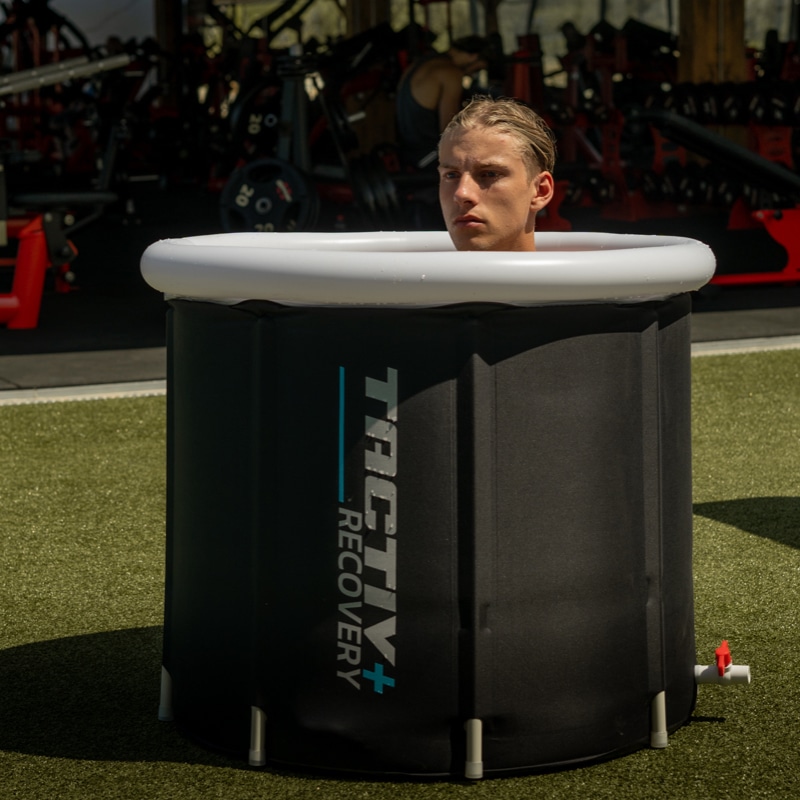Dive into the cold: How cold should an ice bath be?
Welcome to our blog where we talk about ice baths! Whether you’re already familiar with this cool trend or just curious, you’ve come to the right place. In this blog, we take you into the world of ice baths – we explain how cold an ice bath should be, how to keep it cold, and the best way to warm up after a refreshing dip.
How cold is an ice bath?
Ice baths have gained tremendous popularity in recent years, both in the sports world and for general well-being. A fundamental question many people ask is, “How cold is an ice bath?” This is an important aspect for anyone considering taking on this cold challenge.
But wait, there is more! These cold adventures are not just for the brave among us. They offer incredible health benefits. Think reducing inflammation and speeding up muscle recovery. Yes, the first time may feel like a shock to your system, but what follows is a feeling of refreshment and renewal.
Ice baths are more than just a trend; they are a way to restore your body and mind. So, what are you waiting for? Jump in at the deep end and experience this cold but wonderful world of well-being!
How cold should an ice bath be?
Choosing the right temperature for an ice bath is an important aspect that affects both the effectiveness and safety of the experience. This choice is especially important for people who are new to using ice baths. The goal is to strike a balance between an ice bath temperature that is low enough to provide the benefits of cold water therapy, but not so low that it causes discomfort or health risks.
The generally recommended temperature for an ice bath is between 3°C and 15°C. This range is adequate because it is cold enough to stimulate the bodily responses desired in cold therapy, such as reducing inflammation and improving blood circulation, while limiting the risk of hypothermia or other adverse health effects. However, it is essential to realize that the ideal temperature for ice baths can vary depending on personal tolerance, experience and the user’s specific goals.
Want to know how to get your ice bath to your desired temperature? Then read how much ice you need for your ice bath here!
The science behind ice bath temperature
Scientific research indicates that the optimal ice bath temperature ice bath is between 3°C and 15°C. Within this temperature range, the body can benefit from the positive effects of cold exposure, such as reduced muscle soreness and inflammation, without the risk of health problems such as hypothermia. These temperatures are effective in stimulating blood circulation, leading to faster recovery and reduced inflammation. It also contributes to an increased sense of alertness and well-being after bathing. However, it is important to note that the ideal temperature can vary depending on individual factors such as personal tolerance, experience with cold exposure and specific health goals.
Choosing your ice bath temperature should not be taken too lightly. Water that is too cold can cause shock and discomfort, while water that is not cold enough will not deliver the intended benefits of therapy. Therefore, it is recommended to start at the higher end of the recommended range and gradually get used to the cold temperature.
How to keep ice bath cold
Keeping an ice bath cold effectively is an important part of the ice bath experience. Maintaining the proper temperature ice bath goes beyond simply adding ice; it requires thoughtful planning and attention to detail. This is especially important in different climates and seasons, where external temperatures can have a significant impact on the temperature of the bath.
Seasonal influences: Adjustments for cold differences
Seasonal changes have a significant impact on how an ice bath is maintained. During the summer, when ambient temperatures are higher, it is possible to add additional ice or use a chiller to achieve or maintain the ideal temperature. On the other hand, during the winter months, cold weather can help maintain the ice bath’s desired temperature, eliminating or reducing the need for ice.
The key to successfully maintaining the cold temperature of an ice bath, regardless of the season, lies in continuous monitoring and adjustment. Using a thermometer is important to accurately measure the water temperature. Adding ice in controlled amounts helps maintain a stable temperature. In addition, insulating the pool can be an effective way to prevent the temperature from rising too quickly, especially in warmer environments.
It is also important to consider factors such as the duration of the bath and the body temperature of the person taking the ice bath. Longer sessions may require more cooling to keep the temperature stable. In addition, individual differences in the way bodies respond to cold temperatures may necessitate additional adjustments.
In addition to practical temperature maintenance, it is also important to consider how the ice bath is set up and stored. Choosing the right location and type of ice bath can play a large role in how effectively the temperature is maintained. For example, an ice bath exposed to direct sunlight will heat up faster than one in the shade.
How to warm up after an ice bath
A frequently asked question is: how to warm up after an ice bath? Warming up properly after an ice bath is just as important as the ice bath itself. A proper warm-up procedure helps to maximize the benefits of the ice bath and minimize any discomfort or health risks. The process of warming up should be done gradually and carefully to give the body a chance to adjust to the changing temperatures. Should you experience cold shock, which is a physiological reaction that occurs when the body is suddenly exposed to cold water, you can shower warmly after an ice bath. This will ensure that you give your body a hand in regaining its temperature.
Warming up after ice bath: Essential tips
After leaving the ice bath, it is crucial to slowly warm up the body. Immediately switching to an extremely warm environment, such as a hot shower or sauna, can be a shock to the body and is best avoided. Instead, it is recommended to start with light physical activity, such as walking or gentle stretching exercises. This helps stimulate blood circulation and promotes a gradual increase in body temperature.
Wearing warm clothing, standing by a campfire or stove and using blankets can also help with the warming process. It is important to focus on warming the core of the body, followed by the limbs. Consuming hot drinks, such as tea or hot water, can also contribute to the internal warming process.
Listening to the body during this process is important. Some people can warm up faster than others, and overheating after an ice bath can be just as dangerous as hypothermia. It is essential to watch for signs of dizziness, nausea or excessive fatigue, as these may be indicators that the body is struggling to cope with the temperature change.
In addition to the physical aspect of warming up, it is also important to promote mental relaxation after an ice bath. This can be done through breathing exercises or meditation. These techniques not only help regulate body temperature, but also reduce stress and increase overall well-being.
How cold should ice bath be: Experts share insights
Determining the ideal temperature for an ice bath is an important topic in the world of cold therapy and physical recovery. Experts from various disciplines, including sports medicine, physiology and wellness, offer valuable insights into what the optimal temperature for an ice bath should be. These insights are crucial for anyone interested in safely and effectively incorporating ice baths into their routine.
Brrrr … how many degrees is an ice bath?
The ideal ice bath temperature is between 3°C and 15°C. This temperature is cold enough to experience the benefits of cold water therapy, such as reducing muscle pain and inflammation, and improving blood circulation. At the same time, it is warm enough to minimize the risks of hypothermia and other related health problems.
This recommended ice bath temperature is based on research and practical experience. It allows users to gradually get used to the cold and extend the time in the bath as their bodies adjust. It is important to emphasize that individual tolerance to cold can vary, and some people may feel comfortable at slightly higher or lower temperatures.
It is crucial that ice baths be taken under safe conditions, with a clear understanding of how long to stay in the bath and how best to warm up afterwards. Experts recommend starting with short sessions, especially for beginners and gradually increasing the duration as tolerance to the cold increases.
The recommended temperature and practices surrounding ice baths reflect a growing understanding of the role cold therapy can play in physical recovery and overall well-being. By following these guidelines, users of ice baths can enjoy the benefits while minimizing the risks.
Explore further
Now that the question “how cold is an ice bath?” has been answered and you know what the ideal ice bath temperature is, you’re ready for the next step. The next step is to discover what the benefits of an ice bath are. The world of ice bathing is fascinating and multifaceted, with a wealth of information and techniques to explore. Whether you are a beginner or someone looking to deepen their knowledge and experience, there is always more to learn about the benefits, methods and best practices of ice bathing. Learn more on our blogs here!
Are you looking for an Ice Bath?
Check out our ice bath bundles now and receive an instant discount with the code “TACTIV10”.

